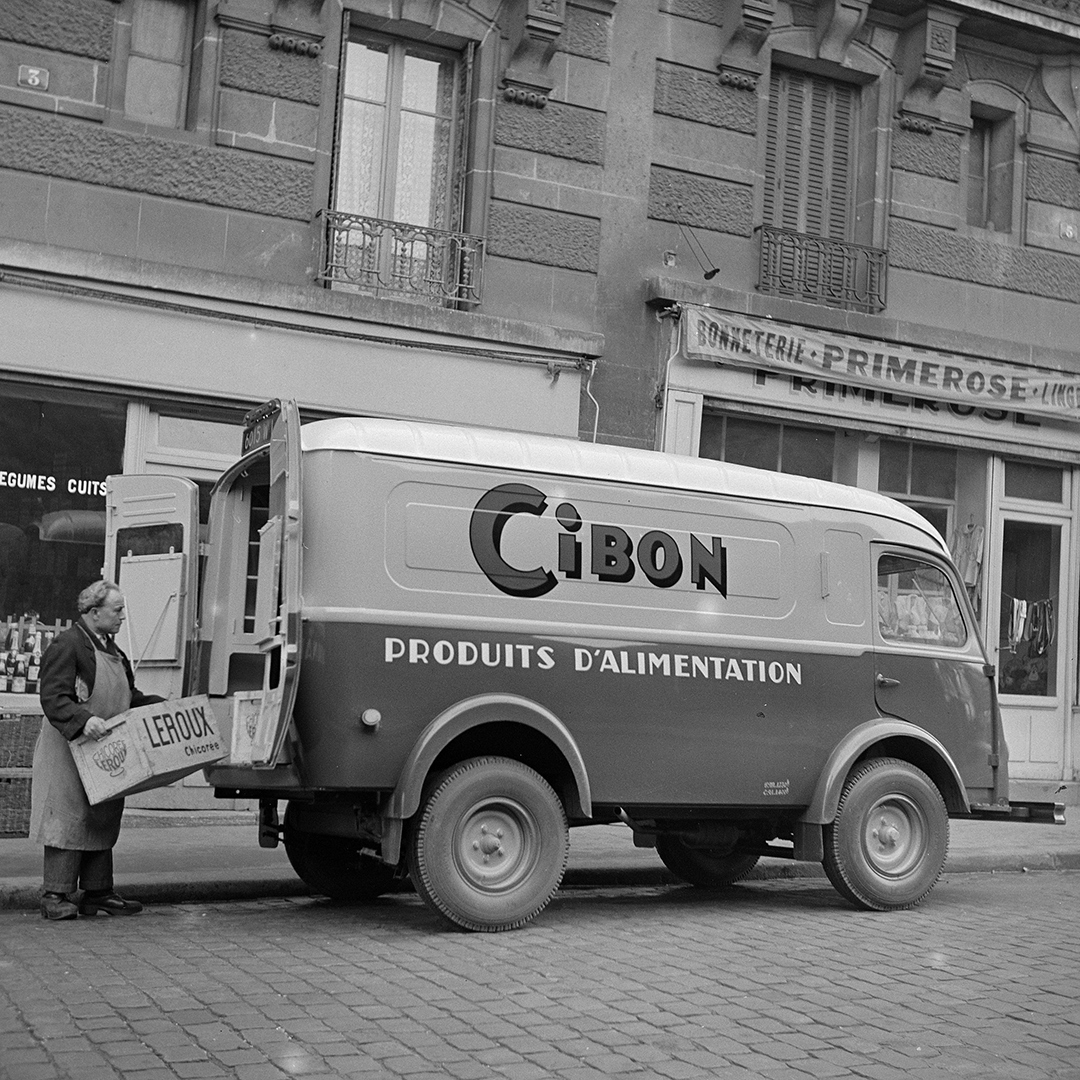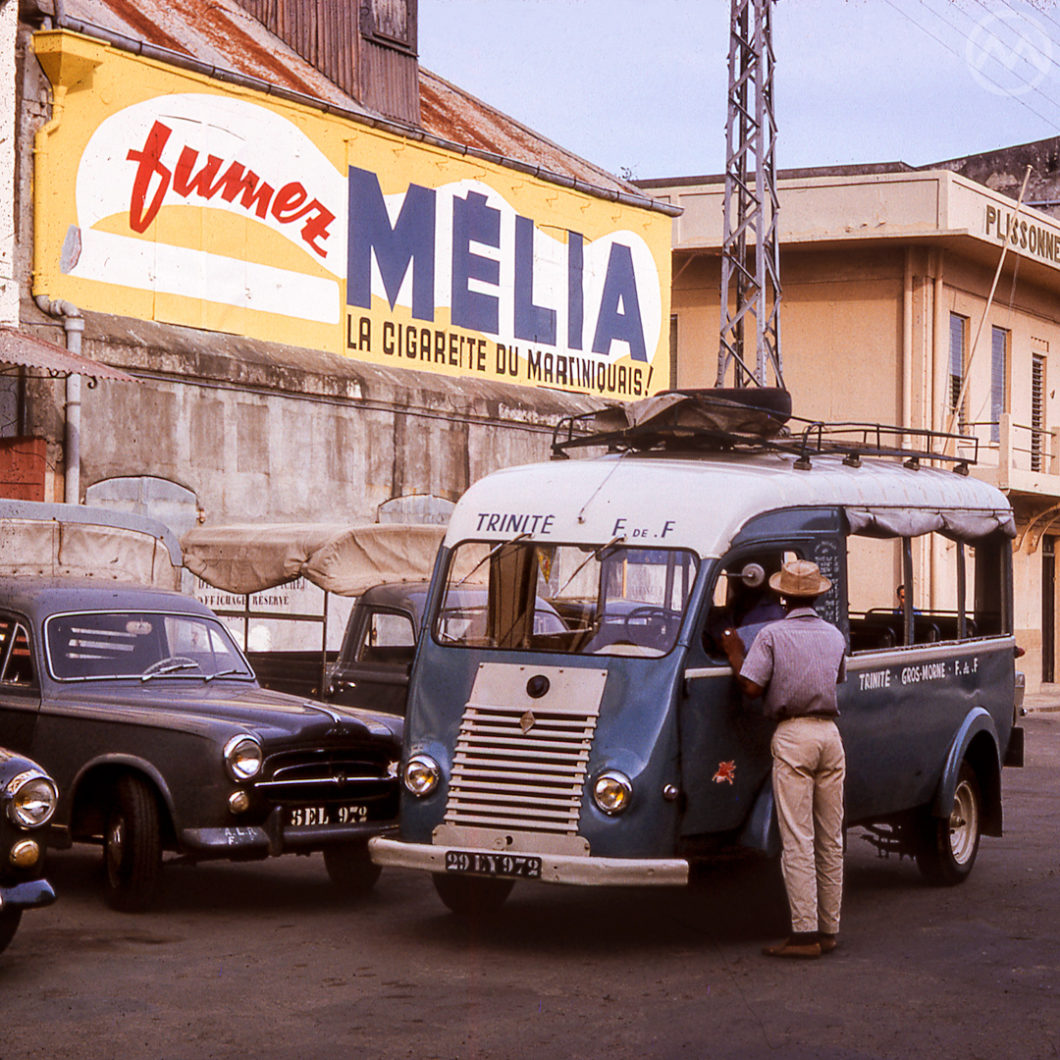A gaggle of rare French machines from the OldMotors archive today; once again from Martinique. A trio of Peugeot 403 pickups are fronted by a Renault Goélette minibus, set to take people from Fort-de-France to the inland community of Gros Morne and then on to the east side of the Island and La Trinité.
All of these vehicles are designed for work, and all are rare today, though the Peugeots are considerably more numerous, as they were built until the mid-1980s. The Goélette only got that name in 1959, but the van dates all the way back to 1945. Both it and its slightly lower capacity sister, the Renault Voltigeur, debuted at the end of that year as the company’s new Type 206 1,000kg van, with the 1,400kg version following in 1949.
A decade later, the 1,000 became the Voltiguer and the 1,400 the Goélette as Renault debuted a new front-drive van with a name, the Estafette. There were also related heavy-duty 2,500kg+ versions, which later became the Renault Galion. All of them were very popular trucks in France and francophone countries and territories, but the story of all of these vans and trucks goes back to prewar times.
Forward Control Vans & Trucks
As early as 1934 Renault had wanted to build forward-control trucks. Car-based trucks and conventional front-engine cabs, Renault figured, devoted too much of the vehicle’s footprint to the engine and not enough to the load area.
In 1937, Renault released the first of these trucks, the 2.5 to 3-ton type AGP, and was trying to popularize the concept. The AGP was sold alongside the company’s conventional-cab trucks, but it continued to refine the forward-control unit and eventually dropped the regular trucks. The idea, however, hadn’t yet trickled down to even smaller vehicles, where space efficiency was even more important.
Rival companies Citroën and Chenard-Walcker, the latter then in considerable financial decline, had similar ideas for small-scale forward-control trucks and vans around the same time. Citroën got there first with 1939’s TUB van. Though the TUB (Traction Utilitaire type B) was not built in any real numbers, its bread-loaf shape and amazing space efficiency were clearly a big edge for commercial vehicle operators in European cities, with their tight confines and medieval layouts.
Under Nazi occupation, Renault built a long string of forward-control military trucks based on the AGx types, and the Type 206 was an extension of those, just scaled down under the direction of engineer Fernand Picard. France needed commercial trucks after the war and a new small-scale forward control van was a natural evolution of the AG-type heavy trucks.
It was ready by mid-1945 and fit well within the “Plan Pons,” a plan for rationalizing the French car and truck industries by technocrat Paul-Marie Pons and minister of industry Robert LaCoste. Under this plan Renault and Chenard-Walcker were to build vans between 1,000 and 1,400kg capacities, and Citroën would be charged with focusing on larger trucks.

The new 1000KG fit right in, but Citroën utterly ignored the plan and evolved the TUB/TUC vans into the H-van, which became a best-seller and sent Renault back to the drawing board to develop something smaller than the Type 206 vans. In the meantime though, the 1,000KG van and its 1,400kg derivative were hugely successful.
The 1000KG was tough, simple, and space-efficient. It was a big metal box on a conventional frame with rear-wheel drive; and initially power came from Renault’s ancient Type 603 engine, first produced in 1919 and in the 1,000kg a 2.4-liter unit making 48 horses. Later it got the more powerful and modern, but smaller, engine from the Renault Frégate, and after a few diesels.
It was meant to fill the gap between Renault’s tiny Juvaquatre van and the big Renault heavy trucks. At first it had no competition, but Chenard-Walcker’s CPV appeared in late 1946 and the H-van about a year later.
1,000KG to Goélette
The 1,000KG was gradually improved over time, losing wood-frame components in favor of metal, getting the heavier-duty version, and ultimately blossoming into a wide variety of configurations including 4WD versions meant for desert uses, primarily in Algerian oil fields.
One of the rarest versions of the truck is the 1000KG Marchande or “Merchant” van, which had roll-up sides for farmers and merchants to sell wares out of in cities and villages. It could also be used, in warm climes, as a “plein aire” minibus like this one.
Roll-up side vans were common in most countries before the advent of modern supermarkets, and Detroit’s Big 3 had roll-side merchant trucks too, though never forward control ones. Supermarkets, and the flight for the suburbs in the post-ww2 era, meant that the neighborhood produce truck guy was largely a thing of the past in the USA after 1960, but in other countries the market truck continued for a long time, and still exists in certain forms.
Citroën’s decision to ignore the Plan Pons meant Renault eventually went back to the well to figure out how to compete with the more popular H-van. The result was the slightly smaller Estafette van of 1959, Renault’s first front-wheel drive product and a much more H-van like machine with its low-loader floor.
When developing the Estafette, Renault’s engineers had looked at the VW type 2, as a rear-engined vehicle would’ve been cheaper to build with all the rear-engine infrastructure Renault had on hand, but decided the floor was too high.
When the Estafette appeared, the 1,000KG and 1,400KG suddenly got names, the smaller becoming the Voltigeur and the larger the Goélette. The Estafette undercut the 1,000kg Voltiguer and it was withdrawn in 1963, but the heavier-duty 1,400kg Goélette remained in production until 1965 and got a bigger replacement, the Super Goélette, built by Renault subsidiary Saviem, created in 1955 to build the commercial trucks.
Chenard-Walcker’s forward control van, the CPV, became the Peugeot D3 when that company fully absorbed C-W in 1950, and it ran into the mid-1960s as well before giving way to the Peugeot J7. Peugeot’s 403 pickup served much longer, with production continuing in Africa until 1988.
There’s a lot going on in the main photo at the top of our story, and it seems like it could be morning or afternoon, with these trucks either waiting to go out or have done their jobs for the day. Mélia Cigarettes seem to have originated in Algeria, though if anybody knows more about them, don’t hesitate to comment!

